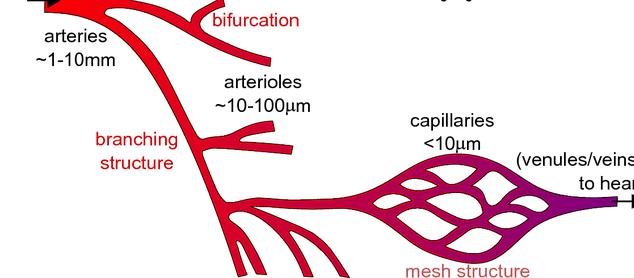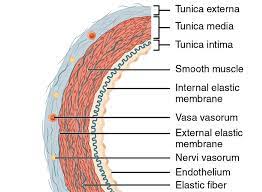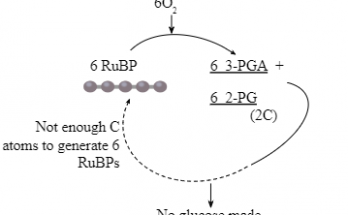Have you ever wondered how Blood gets transported to every part of your body? The answer lies in a complex network of Blood Vessels that includes Arteries, Veins and Capillaries.
Arteries are one of the most important components of the circulatory system, responsible for delivering oxygen and nutrients to all parts of the body. These Blood Vessels are thick and muscular, designed to withstand the high pressure of Blood flow that occurs every time the Heart beats.
In this article, we’ll focus on Arteries and explore their anatomy, function and how they differ from Veins. Arteries are responsible for carrying oxygenated Blood away from the Heart and distributing it to every part of the body, from your brain to your toes. Without them, your body wouldn’t be able to function properly. So, let’s dive in and learn more about these essential Blood Vessels!
Table of Contents
What are Arteries
Arteries are Blood Vessels that carry oxygen-rich Blood away from the Heart and transport it to every part of the body. They are a crucial part of the circulatory system which is responsible for supplying oxygen and nutrients to all the organs and tissues in the body.
Arteries are typically thicker and more muscular than Veins and they have a more elastic, flexible structure that allows them to expand and contract with each Heartbeat. They have a relatively narrow Lumen or inner diameter which helps to maintain the pressure and flow of Blood as it moves away from the Heart.
Arteries are divided into two main types-
- Systemic Arteries
- Pulmonary Arteries.
Systemic Arteries carry oxygen-rich Blood from the Heart to the rest of the body while pulmonary Arteries carry oxygen-poor Blood from the Heart to the lungs, where it can be oxygenated before being returned to the Heart.
Arteries can vary in size and structure depending on their location and function. The largest Artery in the body is the Aorta. Aorta emerges from the left ventricle of the Heart and branches out into smaller Arteries that supply Blood to the rest of the body. Other major Arteries include the carotid Arteries, which supply Blood to the brain and head and the femoral Arteries, which supply Blood to the legs and lower body.
Structure of The Arteries

Arteries can vary in size and shape depending on their location and function within the body. The largest Artery in the body is the Aorta, which emerges from the left ventricle of the Heart and branches into smaller Arteries throughout the body. The Arteries that branch off the Aorta are progressively smaller in diameter and they eventually give rise to arterioles, which are even smaller vessels that connect to Capillaries. Capillaries are the smallest Blood Vessels in the body and are responsible for exchanging oxygen, nutrients and waste products between the Blood and the surrounding tissues.
Also check – Why Do Arteries Have Thick Elastic Walls ?
Layers of The Arteries
Arteries are composed of three main Layers, each with a distinct structure and function. These Layers are-
- Tunica Intima
- Tunica Media
- Tunica Adventitia

Tunica Intima
The Tunica Intima is the innermost Layer of the Artery and it is composed of a single Layer of endothelial cells that are in direct contact with the Blood flowing through the vessel. These cells help to regulate the diameter of the Artery and prevent Blood clotting by secreting anticoagulant molecules. The Tunica Intima also contains a thin Layer of connective tissue and a small number of smooth muscle cells.
Function of Tunica Intima
The important role of the Tunica Intima is to protect the innermost Layer of the Artery, which is the endothelial lining. The endothelial cells in the Tunica Intima help to prevent the formation of Blood clots and regulate Blood flow by releasing substances that cause the smooth muscle in the Tunica Media to either contract or relax. Additionally, the Tunica Intima serves as a barrier between the Blood and the other Layers of the Artery.
Also check -8 Structural and Functional Difference Between Arteries Veins and Capillaries
Tunica Media
The Tunica Media is the middle Layer of the Artery and is composed primarily of smooth muscle cells and elastic fibers. The smooth muscle cells are arranged in concentric rings around the Lumen of the Artery and are responsible for regulating the diameter of the vessel.
Functions of Tunica Media
The role of the Tunica Media is to regulate the diameter of the Artery and maintain Blood Pressure. The smooth muscle cells in this Layer can contract or relax in response to a variety of physiological stimuli such as changes in Blood Pressure or the release of hormones. This Layer is also responsible for maintaining the structural integrity of the Artery, particularly in response to changes in Blood Pressure.The elastic fibers in the Tunica Media also allow the Artery to expand and contract with each Heartbeat.
Also Check – 15 Important Differences Between Arteries and Veins
Tunica Adventitia
The Tunica Adventitia is the outermost Layer of the Artery and is composed of connective tissue collagen fibers and a small number of elastic fibers.
Functions of Tunica Adventitia
The Tunica Adventitia is the outermost Layer of the Artery and provides structural support to the vessel. This Layer is particularly important in larger Arteries, where it helps to anchor the vessel in place within the body. It also contains small Blood Vessels, nerves and lymphatic vessels that supply oxygen and nutrients to the Artery.
Functions of Arteries
Arteries play a critical role in the circulatory system, which is responsible for supplying oxygen and nutrients to all the organs and tissues in the body. Arteries accomplish this by carrying oxygen-rich Blood away from the Heart and delivering it to the body’s different parts. Some of the specific functions of Arteries are as follows –
- Transporting oxygen-rich Blood – The primary function of Arteries is to carry oxygen-rich Blood away from the Heart and distribute it to every part of the body. This ensures that all the organs and tissues receive the oxygen and nutrients they need to function properly.
- Regulating Blood Pressure – Arteries play a crucial role in regulating Blood Pressure by maintaining a consistent flow of Blood throughout the body. The muscular walls of Arteries are able to contract and relax to adjust the diameter of the Blood Vessels and control the amount of Blood flowing through them.
- Delivering nutrients – Arteries not only transport oxygen but also other essential nutrients such as glucose, amino acids and fatty acids, to the organs and tissues that need them. This helps to fuel the body’s metabolic processes and maintain overall health and well-being.
- Removing waste products – In addition to delivering nutrients Arteries also help to remove waste products such as carbon dioxide and lactic acid, from the body. This is done by carrying oxygen-poor Blood away from the tissues and back to the Heart, where it can be pumped to the lungs for oxygenation.
- Distributing Hormones – Arteries also play a role in distributing hormones and other signaling molecules throughout the body. Hormones are secreted by various glands and organs and are carried in the Bloodstream to their target tissues where they regulate a wide range of physiological processes.
- Supporting immune function: Arteries also support the body’s immune function by transporting immune cells such as white Blood cells to sites of infection or injury. These cells are responsible for identifying and neutralizing foreign invaders such as viruses and bacteria to protect the body from infection and disease.
Also Check – Difference between Double Circulation and Single Circulation
Frequently asked Questions on Arteries – Structure , Layers, Functions
What are Arteries and what is their role in the circulatory system?
Arteries are Blood Vessels that carry oxygen-rich blood away from the heart and transport it to every part of the body. They play a crucial role in the circulatory system by supplying oxygen and nutrients to all the organs and tissues in the body.
How do Arteries differ from Veins?
Arteries are typically thicker and more muscular than Veins and they have a more elastic, flexible structure that allows them to expand and contract with each heartbeat. They also have a relatively narrow lumen or inner diameter which helps to maintain the pressure and flow of blood as it moves away from the heart. In contrast, Veins carry blood towards the heart, have thinner walls and larger lumens to accommodate the blood returning to the heart with less pressure.
What are the two main types of Arteries and what are their functions?
The two main types of Arteries are systemic Arteries and pulmonary Arteries. Systemic Arteries carry oxygen-rich blood from the heart to the rest of the body, while pulmonary Arteries carry oxygen-poor blood from the heart to the lungs, where it can be oxygenated before being returned to the heart.
What is the largest Artery in the body and what is its function?
The largest Artery in the body is the aorta. It emerges from the left ventricle of the heart and branches out into smaller Arteries that supply blood to the rest of the body.
What are the three main layers of an Artery and what are their functions?
The three main layers of an Artery are the Tunica Intima, Tunica Media and Tunica Adventitia. The Tunica Intima is the innermost layer and is composed of a single layer of endothelial cells that help to regulate the diameter of the Artery and prevent blood clotting by secreting anticoagulant molecules. The Tunica Media is the middle layer and is primarily composed of smooth muscle cells and elastic fibers that are responsible for regulating the diameter of the Artery and maintaining blood pressure. The Tunica Adventitia is the outermost layer and is composed of connective tissue collagen fibers and a small number of elastic fibers that protect and anchor the Artery to surrounding tissues.
What is the role of the Tunica Intima in the Artery?
The Tunica Intima is the innermost layer of the Artery and is composed of endothelial cells that help to regulate the diameter of the Artery and prevent blood clotting by secreting anticoagulant molecules. It also serves as a barrier between the blood and the other layers of the Artery.
What is the role of the Tunica Media in the Artery?
The Tunica Media is the middle layer of the Artery and is primarily composed of smooth muscle cells and elastic fibers that are responsible for regulating the diameter of the Artery and maintaining blood pressure. The elastic fibers in the Tunica Media allow the Artery to expand and contract with each heartbeat.
What is the role of the Tunica Adventitia in the Artery?
The Tunica Adventitia is the outermost layer of the Artery and is composed of connective tissue collagen fibers and a small number of elastic fibers that protect and anchor the Artery to surrounding tissues.
What are the functions of Arteries in the body?
The functions of Arteries in the body include carrying oxygen-rich blood away from the heart and distributing it to every part of the body, maintaining blood pressure and blood flow, regulating the diameter of the Artery and providing structural support to the circulatory system. Arteries play a crucial role in supplying oxygen and nutrients to all the organs and tissues in the body.


7 Comments on “Arteries – Structure , Layers, Functions”